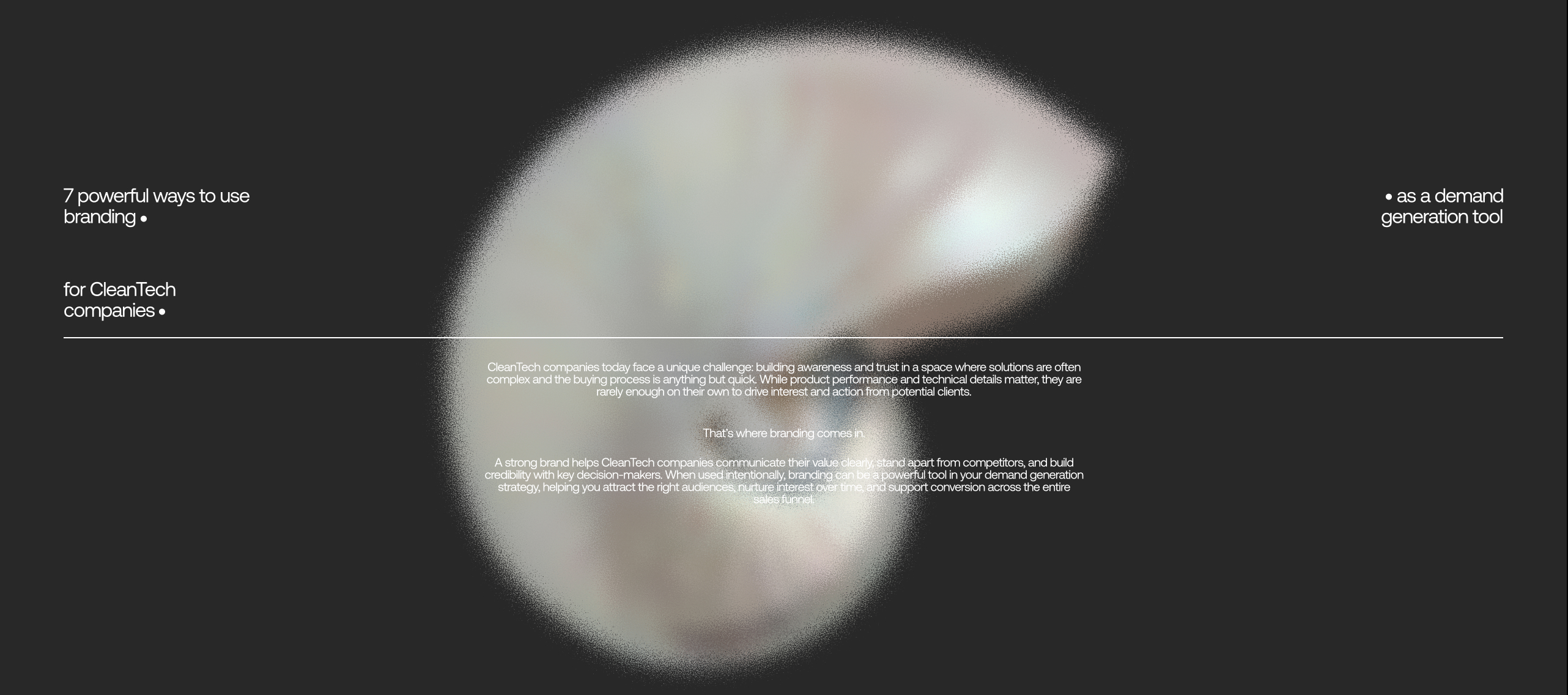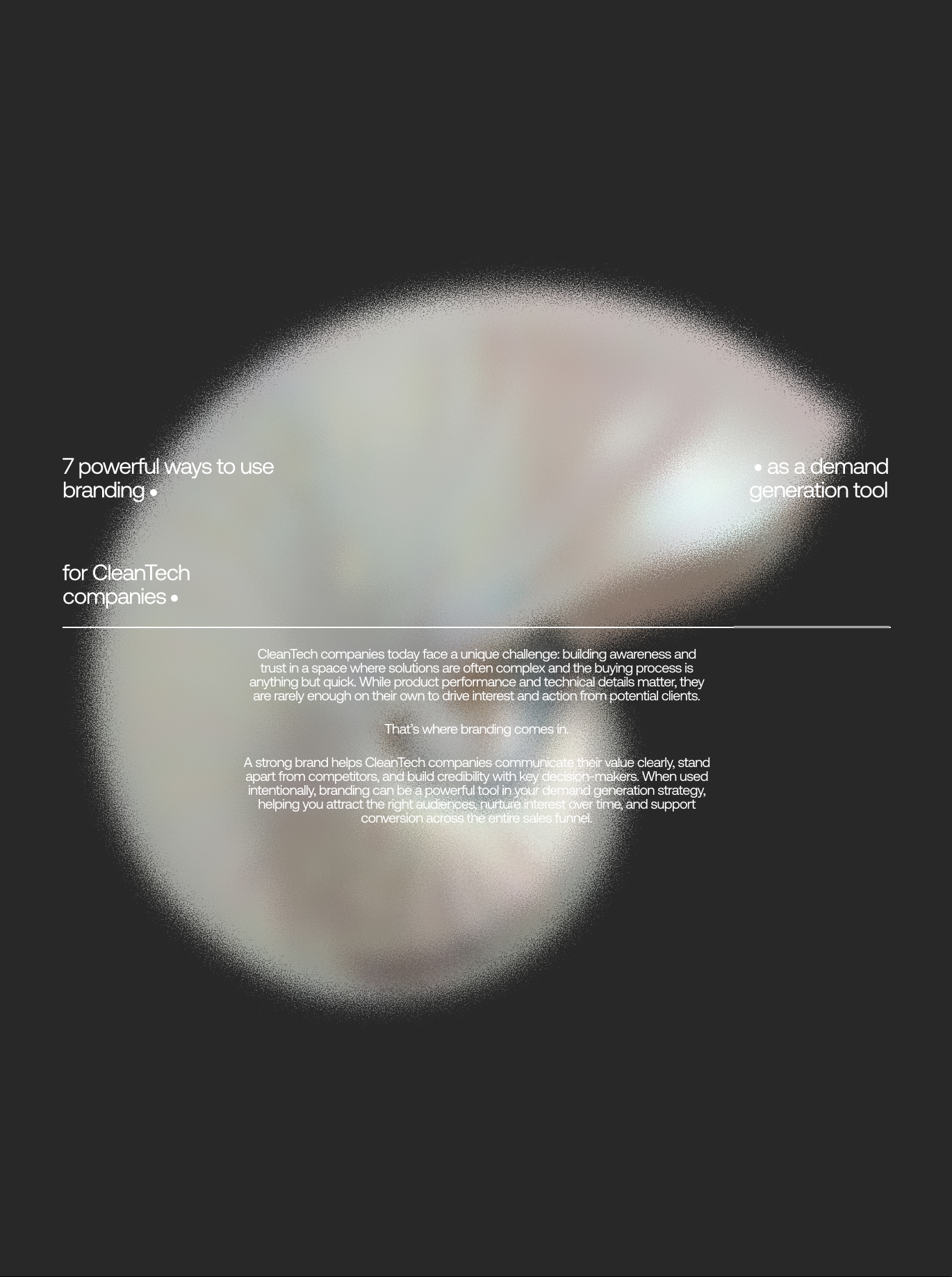

7 powerful ways to use branding as a demand generation tool for CleanTech companies
Branding
25/7/2025
CleanTech companies today face a unique challenge: building awareness and trust in a space where solutions are often complex and the buying process is anything but quick. While product performance and technical details matter, they are rarely enough on their own to drive interest and action from potential clients.
That’s where branding comes in.
A strong brand helps CleanTech companies communicate their value clearly, stand apart from competitors, and build credibility with key decision-makers. When used intentionally, branding can be a powerful tool in your demand generation strategy, helping you attract the right audiences, nurture interest over time, and support conversion across the entire sales funnel.
This article explores 7 practical ways to use branding as a demand generation tool for CleanTech companies, offering clear steps and real examples to guide your marketing and sales efforts.
1. Why branding matters in B2B demand generation for CleanTech
Understanding the CleanTech audience
CleanTech companies operate in a dynamic, innovation-driven market where decision-makers seek more than just technical specs, they want to trust the brand. For B2B buyers in clean energy, sustainability, and decarbonisation spaces, branding is a signal of reliability and future vision.
• These buyers are cautious and well-informed.
• They evaluate long-term partnerships, not just one-off purchases.
• They expect transparency, ethics, and impact.
Differentiation in a crowded market
With rising startups and legacy players pivoting toward sustainable solutions, CleanTech has become competitive. A clear, consistent brand voice helps your company stand out.
• Branding as a demand generation tool helps distinguish value beyond features, emphasising purpose, mission, and innovation.
• It attracts partners, investors, and clients aligned with environmental goals.
Building trust with sustainability-focused buyers
Modern B2B buyers interact with your brand across multiple touchpoints like social media, blogs, webinars, and more. Strong branding builds trust and familiarity at every stage of the user journey, which is essential in high-investment verticals like CleanTech.
2. How to align your brand strategy with demand generation goals
Clarify demand generation strategy objectives
Before aligning brand and demand generation, define clear goals:
• Increase high-quality leads
• Boost engagement across platforms
• Shorten the sales cycle
• Improve conversion rate optimisation (CRO)
Define target audience and buyer personas
Craft buyer personas tailored to CleanTech sectors, utilities, governments, commercial buildings, or manufacturing. Understand their:
• Pain points
• Budget constraints
• Sustainability priorities
This ensures both brand messaging and demand generation tools align with specific needs.
Tailor brand messaging to the inbound marketing funnel
Each stage of the inbound marketing funnel should reflect your brand values:
• TOFU (Top of funnel): Awareness via thought leadership, SEO, and social media
• MOFU (Middle of funnel): Educational content like whitepapers and webinars
• BOFU (Bottom of funnel): Case studies, testimonials, and direct consultations
Integrate branding into sales and marketing teams
Ensure both sales and marketing teams collaborate on branding:
• Share consistent messaging
• Co-develop branded sales content
• Use shared metrics and marketing automation tools for seamless execution
3. Top demand generation tools that support brand-led growth
Marketing automation platforms
Marketing automation platforms are crucial for CleanTech marketers aiming to scale branded demand generation campaigns.
Email marketing & lead scoring
Use platforms like HubSpot or Marketo to:
• Run personalised email campaigns
• Implement lead scoring to identify qualified leads
• Automate responses based on client interactions
Personalised marketing campaigns
With tools like Salesforce Pardot, you can create personalised experiences across channels like email, ads, and landing pages.
Content marketing & SEO tools
Use SEMRush, Surfer SEO, or Clearscope to optimise:
• Blogs, whitepapers, and guides with LSI and long-tail keywords
• Drive organic traffic and increase website visitors
• Track keyword rankings for demand generation marketing
Account-based marketing solutions
Tools like Terminus and 6sense help you:
• Target specific companies
• Create demand via hyper-targeted ads and content
• Align content with account-specific challenges
Analytics & robust reporting dashboards
Use Google Analytics, Hotjar, and HubSpot Dashboards to track:
• Lead behaviour across your website
• Click-through rates on landing pages
• Impact of social media campaigns and email campaigns
4. Branding touchpoints to strengthen your demand generation funnel
TOFU – Creating awareness and interest

Social media campaigns & website visitors
Your TOFU branding should focus on:
• Creating awareness through infographics, video explainers, and webinars
• Utilising platforms like LinkedIn, Twitter, and YouTube
• Directing social media traffic to branded blogs and landing pages
SEO, blog content, and inbound tactics
Use search engine optimisation tactics such as:
• Keyword-optimised blog posts
• Guest blogging on sustainability publications
• Leveraging demand generation software for content distribution
MOFU – Engaging leads across platforms
Landing pages & content offers
MOFU assets should nurture leads using:
• eBooks and whitepapers with strong brand visuals
• A/B tested landing pages to maximise conversions
• Split URL testing for CTA and content placements
Email campaigns & marketing platform integration
Create:
• Drip email sequences that align with persona-specific pain points
• Integrate CRMs and marketing platforms for centralised tracking
BOFU – Converting qualified leads
Sales collateral & personalised demos
BOFU branding includes:
• Branded decks and proposal templates
• Product demo videos with your brand narrative
Lead nurturing and conversion optimisation
Use tools like Unbounce and Instapage to:
• Test conversion rate optimisation elements
• Present value-driven CTAs aligned with branding
5. Measuring brand‑driven demand generation success
KPIs across the demand generation process
Track these KPIs to gauge success:
• New qualified leads
• Email open and click rates
• Landing page conversions
• Content downloads
Analytics for entire user journey
Map out the entire user journey:
• From brand awareness to purchase
• Using heatmaps, user journeys, and attribution models
Optimising ad spend and marketing campaigns
Leverage platforms like Google Ads, LinkedIn Campaign Manager, and Meta Ads Manager to:
• Monitor ad spend efficiency
• A/B test creative assets
• Retarget high-intent website visitors
Customer retention & long-term brand equity
Measure:
• Repeat purchases
• Client retention rates
• Brand mentions and sentiment on social media platforms
6. FAQs – Clearing common doubts on branding & demand generation
What is demand generation vs lead generation?
Demand generation builds interest and awareness, while lead generation captures data from interested prospects. Demand gen is the broader strategy while lead gen is one of its outcomes.
How does branding support inbound marketing?
Branding ensures your inbound tactics, such as blogs, videos, and SEO, carry a consistent voice, which builds trust and drives engagement across touchpoints.
Which demand generation tools are best for CleanTech?
• HubSpot: All-in-one CRM and marketing automation
• Terminus: Account-based marketing for CleanTech B2B
• Marketo: Email and lead scoring at scale
How to align marketing and sales teams effectively?
• Use a shared CRM platform
• Define SLAs between marketing and sales
• Co-create branded content for the sales pipeline
How to measure ROI on brand-led demand initiatives?
Track attribution, compare lead quality, and evaluate user lifetime value across brand campaigns.
What role does account-based marketing play?
It helps target specific companies with personalised messages, improving conversion for high-value B2B CleanTech deals.
Conclusion: Embracing branding for demand gen in Cleantech
In the CleanTech sector, branding is a demand generation tool that drives awareness, trust, and long-term growth. By using modern demand generation tools, aligning messaging with the sales funnel, and tracking performance, CleanTech companies can attract quality leads, engage with specific companies, and convert interest into partnerships.
Ready to take your CleanTech brand to the next level? Build a cohesive strategy that bridges branding and demand gen today.
Recent Articles
content on
-min.png)



.svg)

